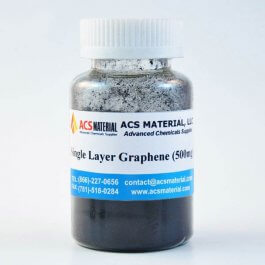Single Layer Graphene (Graphene Factory)
CAS No.: 7782-42-5
Single-layer graphene has emerged as a highly capable material that has the ability to replace outdated technologies and benefit countless industries. Incredibly lightweight yet highly durable, graphene is able to conduct a high level of electricity through a miniscule amount of material. Applications of graphene include small electrical circuits and outlets, medical equipment, solar cells, and more. Due to its flexible nature, CAS No.: 7782-42-5
Single-layer graphene has emerged as a highly capable material that has the ability to replace outdated technologies and benefit countless industries. Incredibly lightweight yet highly durable, graphene is able to conduct a high level of electricity through a miniscule amount of material. Applications of graphene include small electrical circuits and outlets, medical equipment, solar cells, and more. Due to its flexible nature, CAS No.: 7782-42-5
| Preparation Method | Thermal exfoliation reduction + Hydrogen reduction |
| BET surface area (m2/g) | 650~750 |
| Conductivity (S/m) | 500~700 |
| Layers | 1-5 atomic layer graphene nanosheets |
| Lateral size (µm) | 0.5-5 |
| Oxygen (at%) | 7-7.5 |

TEM Image of Single Layer Graphene (ACS Material-Graphene Factory)

SEM Image of Single Layer Graphene (ACS Material-Graphene Factory)

HRTEM Image of Single Layer Graphene (ACS Material-Graphene Factory)

XRD Patterns of Single Layer Graphene (ACS Material-Graphene Factory)


XPS Patterns of Single Layer Graphene (ACS Material-Graphene Factory)

Raman Spectrum of Single Layer Graphene (ACS Material-Graphene Factory)
Research Citations of ACS Material Products
- Chaiyo, Sudkate, et al. “Electrochemical sensors for the simultaneous determination of zinc, cadmium and lead using a Nafion/Ionic liquid/Graphene composite modified screen-Printed carbon electrode.” Analytica Chimica Acta, vol. 918, 2016, pp. 26–34., doi:10.1016/j.aca.2016.03.026.
- Illakkiya, J. Tamil, et al. “Nebulized spray pyrolysis: a new method for synthesis of graphene film and their characteristics.” Surface and Coatings Technology, vol. 307, 2016, pp. 65–72., doi:10.1016/j.surfcoat.2016.08.051.
- Illakkiya, J. Tamil, et al. “Nanoarchitectured Semiconducting Photoelectrodes for Enhanced Stability and Photon Conversion Efficiency.” Carbon, vol. 111, 2017, pp. 713–721., doi:10.1016/j.carbon.2016.09.042.
- Nieto, Andy, et al. “Graphene reinforced metal and ceramic matrix composites: a review.” International Materials Reviews, vol. 62, no. 5, 2016, pp. 241–302., doi:10.1080/09506608.2016.1219481.
- Tiwari, Santosh Kr., et al. “Conductive Polymer Composites Based on Carbon Nanomaterials.” Springer Series on Polymer and Composite Materials Conducting Polymer Hybrids, Mar. 2016, pp. 117–142., doi:10.1007/978-3-319-46458-9_4.
- Chaiyo, Sudkate, et al. “Non-Enzymatic electrochemical detection of glucose with a disposable paper-Based sensor using a cobalt phthalocyanine–ionic liquid–graphene composite.” Biosensors and Bioelectronics, vol. 102, 2018, pp. 113–120., doi:10.1016/j.bios.2017.11.015.
- Lazarević-Pašti, Tamara, Vladan Anićijević, Miloš Baljozović, Dragana Vasić Anićijević, Sanjin Gutić, Vesna Vasić, Natalia V. Skorodumova, and Igor A. Pašti. "The impact of the structure of graphene-based materials on the removal of organophosphorus pesticides from water." Environmental Science: Nano (2018).
- Ali, Nafisa, Priyabrata Pal, Fawzi Banat, and Chandrasekar Srinivasakannan. "Selective removal of diethanolamine from methyldiethanolamine solution using chemically reduced single-layer graphene and activated carbon." Separation Science and Technology (2018): 1-11.



